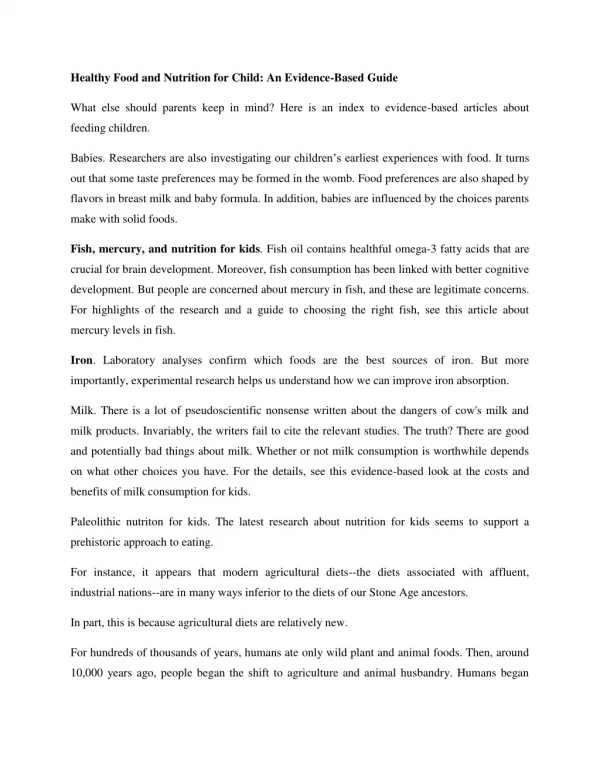Healthy Food and Nutrition for Child: An Evidence-Based Guide
What else should parents keep in mind? Here is an index to evidence-based articles about feeding children. Babies. Researchers are also investigating our children’s earliest experiences with food. It turns out that some taste preferences may be formed in the womb. Food preferences are also shaped by flavors in breast milk and baby formula. In addition, babies are influenced by the choices parents make with solid foods. Fish, mercury, and nutrition for kids. Fish oil contains healthful omega-3 fatty acids that are crucial for brain development. Moreover, fish consumption has been linked with better cognitive development. But people are concerned about mercury in fish, and these are legitimate concerns. For highlights of the research and a guide to choosing the right fish, see this article about mercury levels in fish. Iron. Laboratory analyses confirm which foods are the best sources of iron. But more importantly, experimental research helps us understand how we can improve iron absorption. Milk. There is a lot of pseudoscientific nonsense written about the dangers of cow's milk and milk products. Invariably, the writers fail to cite the relevant studies. The truth? There are good and potentially bad things about milk. Whether or not milk consumption is worthwhile depends on what other choices you have. For the details, see this evidence-based look at the costs and benefits of milk consumption for kids. Paleolithic nutriton for kids. The latest research about nutrition for kids seems to support a prehistoric approach to eating. For instance, it appears that modern agricultural diets--the diets associated with affluent, industrial nations--are in many ways inferior to the diets of our Stone Age ancestors. In part, this is because agricultural diets are relatively new. For hundreds of thousands of years, humans ate only wild plant and animal foods. Then, around 10,000 years ago, people began the shift to agriculture and animal husbandry. Humans began eating food types they’d never eaten before. The human body, adapted to digest a Paleolithic diet, was suddenly challenged with an agricultural diet. Picky eaters. Are you having trouble getting your child to try new foods? Or to eat his vegetables? Some kids are predisposed to be picky eaters. But research suggests several good strategies for coping with picky eaters, such as pairing new foods with sweet flavors. To learn more, see these evidence-based tips for dealing with picky eaters. Probiotics and Prebiotics. Food and supplement manufacturers are pushing prebiotics and probiotics. Are the claims overblown? Perhaps. But studies suggest that probiotic supplements can be an effective treatment for diarrhea, and the daily consumption of prebiotics may bolster the immune system. Vitamin A supplements: Are your kids getting too much A? Kids with diagnosed deficiencies may need extra sources of vitamin A. But many well-nourished kids might be getting too much retinol, or vitamin A, in their multivitamin supplements. Author’s Bio Jos Prick in this piece explore food supplement for children using an evidence-based guide. He looked at how babies are influenced by the choices parents make with solid foods.
★
★
★
★
★
53 views • 2 slides

